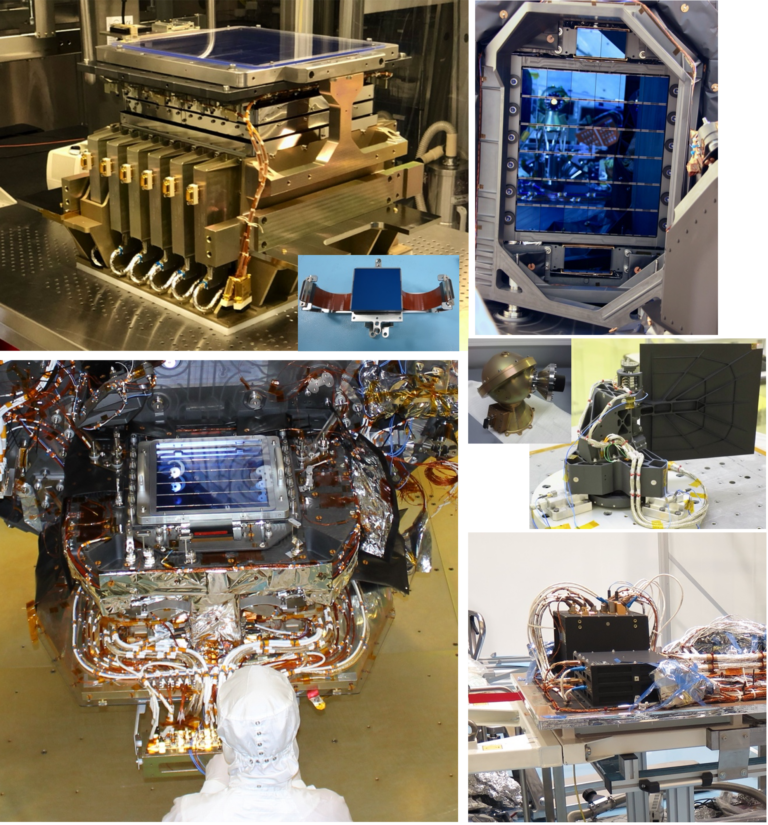The VIS Instrument
The VIS instrument is one of two instruments on Euclid. It is a large format imager, with 609 million pixels covering a field of view of 0.57 deg2 (almost 3 times the solid angle of the full Moon) with 0.1 arcsec sampling. The full image is transmitted to ground, making these the largest images yet for an astronomical satellite. VIS slightly under-samples the telescope point spread function, but this is recovered through multiple exposures, so its effective angular resolution is 0.18 arcsec.
The focal plane consists of 36 CCD273-84, custom designed and manufactured for VIS by e2v (now Teledyne e2v). They are read out from the four corners, resulting in 144 channels of information. The signals in the pixels are digitised to 16 bits resolution, each bit corresponding to 3.4 electrons. The internal noise of the VIS detection chain is less than 4.4 electrons in all channels.
For the Euclid Wide Survey, VIS is typically used in a regular observing sequence lasting just over 4200 sec. During this time four nominal duration exposures of 565 sec and two shorter exposures of 100 sec are taken, together with a number of calibration exposures. These are all sequenced with the NISP instrument to maximise Euclid’s observing efficiency. Euclid will make small pointing displacements between the four nominal exposures to ensure that stars falling in the small gaps between the closely butted detectors are exposed with at least three exposures. Approximately 20 of these fields are observed each day. With three exposures per field, it is expected that a signal-to-noise ratio of 10 will be achieved for a source of IE(AB)=26.0 with 92% of flux within a 1.3 arcsec diameter aperture, typical for a distant galaxy. VIS pixels are saturated at ~200 000 electrons, so that the bright limit (for stars) in the nominal exposure is mAB=17.8 and for the short exposure is IE(AB)=16.0. This ensures sufficient overlap with other surveys and calibrators such as those from Gaia.

Overview of the subsystems composing the VIS instrument.
Top left: The Integrated VIS Focal Plane Assembly with the 36 CCD273-84s under a protective cover at the top of the picture. The electronics to control the CCDs and to digitise the 144 channels of data are below them, separated by thermal shields. The inset shows an individual CCD in a transport jig.
Top right: A front view of the focal plane with 36 VIS CCDs and 4 Fine Guidance Sensor CCDs.
Lower left: The VIS Focal Plane Array being integrated into the Euclid Payload Module.
Middle right: The VIS Calibration Unit and VIS Shutter.
Bottom right: The VIS Command & Data Processing Unit and Power & Mechanism Control Unit integrated onto a Euclid Service Module panel.
Credits: CEA, e2v, Airbus, IAS, APCO.
The large VIS images with their fine angular resolution will be used for many different purposes, but VIS has been built specifically to make shape measurements of distant galaxies. Their distortions resulting from weak gravitational lensing by intervening matter allow the matter distribution to be mapped. This is mostly dark matter. The way its clumpiness has changed with time can be measured by observing galaxies at different distances, and this is a powerful probe of dark energy. Nevertheless, this requires the shapes of more than 1.5 billion faint galaxies to be measured accurately, so VIS observes in only a single broad band from 550nm to 950nm. The absence of filters avoids multiple reflections within them and the errors arising from imperfect registration after filter wheel movements. The optical path to VIS is entirely reflective, although there are ghosts produced from the rear surface of the dichroic which separates the optical and infra-red beams to VIS and NISP. A shutter is necessary to cover the focal plane during the readout of the CCDs and it is finely balanced and momentum compensated, so as not to disturb the satellite pointing during the beginning and end of the VIS exposure. A calibration unit provides flat-filed illumination of the VIS focal plane. Exceptional care has been taken to understand the instrumental biases, and in the calibration regime for the instrument. More than the size and resolution of the VIS instrument, it is these aspects which are most challenging and groundbreaking.
To achieve this, VIS takes as much as possible of its calibration data from within the science image itself. This includes the point spread function, which needs to be known very accurately for the galaxy shape measurement. Other calibrations are carried out within the regular observing sequence, in particular those to measure and track the effect of radiation damage on the CCDs, mostly from Solar protons. This damage changes the recorded shape of the galaxy, so correction is required, especially towards the end of the mission. The CCDs include structures from which electrons can be injected directly into the pixels, and techniques have been developed to map individual damage sites, so these can be accounted for in the data processing on ground.
It should be noted that VIS can achieve its potential for cosmology only within a framework of high stability provided by the satellite and telescope, calibration and survey strategies with an exceptional level of refinement, data processing by the science ground segment respecting the required level of control on biases, and data analysis using the most advanced statistical techniques. This has required a high level of coordination within the Euclid Consortium and the European Space Agency. The VIS instrument was built within the Euclid Consortium by a team of six scientific institutes in the UK, France, Italy and Switzerland, and three industry teams. The system team was at Mullard Space Science Laboratory, University College London. The work was funded by national space agencies.
